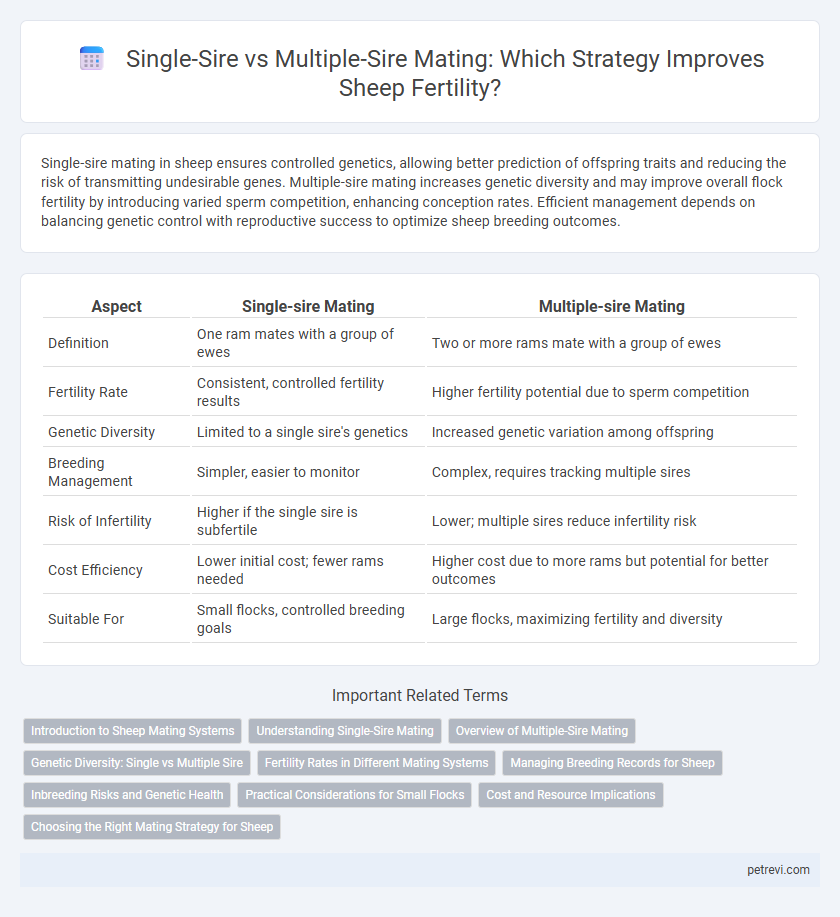Single-sire mating in sheep ensures controlled genetics, allowing better prediction of offspring traits and reducing the risk of transmitting undesirable genes. Multiple-sire mating increases genetic diversity and may improve overall flock fertility by introducing varied sperm competition, enhancing conception rates. Efficient management depends on balancing genetic control with reproductive success to optimize sheep breeding outcomes.
Table of Comparison
| Aspect | Single-sire Mating | Multiple-sire Mating |
|---|---|---|
| Definition | One ram mates with a group of ewes | Two or more rams mate with a group of ewes |
| Fertility Rate | Consistent, controlled fertility results | Higher fertility potential due to sperm competition |
| Genetic Diversity | Limited to a single sire's genetics | Increased genetic variation among offspring |
| Breeding Management | Simpler, easier to monitor | Complex, requires tracking multiple sires |
| Risk of Infertility | Higher if the single sire is subfertile | Lower; multiple sires reduce infertility risk |
| Cost Efficiency | Lower initial cost; fewer rams needed | Higher cost due to more rams but potential for better outcomes |
| Suitable For | Small flocks, controlled breeding goals | Large flocks, maximizing fertility and diversity |
Introduction to Sheep Mating Systems
Single-sire mating in sheep involves placing one ram with a group of ewes, ensuring controlled genetic lineage and easier management of breeding records. Multiple-sire mating allows several rams to mate with a flock, increasing genetic diversity and maximizing fertility rates due to heightened ram-to-ewe ratios. Understanding the differences between these systems is crucial for optimizing flock reproductive performance and genetic improvement strategies.
Understanding Single-Sire Mating
Single-sire mating in sheep breeding involves pairing one ram with a group of ewes, enhancing paternity certainty and enabling precise genetic selection. This method improves reproductive management by reducing the risk of multiple paternity, which is critical for accurate pedigree tracking and optimizing flock genetics. Studies show single-sire mating leads to higher lambing percentages and better lamb survival, supporting improved overall flock fertility and productivity.
Overview of Multiple-Sire Mating
Multiple-sire mating in sheep involves introducing several rams to a flock during the breeding season, which can increase genetic diversity and potentially improve overall fertility rates. This method reduces the risk of infertility caused by a single ram's poor performance and can enhance lambing percentages. However, managing multiple rams requires careful monitoring to prevent aggressive behavior and ensure equitable mating opportunities.
Genetic Diversity: Single vs Multiple Sire
Multiple-sire mating significantly enhances genetic diversity in sheep flocks by increasing the variety of paternal alleles, which can improve overall flock health and resilience. Single-sire mating limits genetic variation, potentially leading to inbreeding and reduced fertility over generations. Managing sire diversity strategically helps maintain robust genetic pools essential for sustainable sheep breeding programs.
Fertility Rates in Different Mating Systems
Single-sire mating in sheep often results in more predictable and consistent fertility rates due to controlled breeding and better monitoring of individual ram performance. Multiple-sire mating can increase genetic diversity but may lead to variable fertility rates influenced by ram dominance and sperm competition. Studies show that single-sire mating typically achieves higher conception rates, while multiple-sire systems require management strategies to optimize overall flock fertility.
Managing Breeding Records for Sheep
Managing breeding records in single-sire mating ensures clear paternity tracking, enhancing accuracy in pedigree and genetic evaluations for sheep fertility. In multiple-sire mating, recordkeeping becomes complex, requiring advanced identification techniques such as DNA testing to accurately assign lamb parentage. Reliable breeding records support informed decisions on genetics, improving reproductive outcomes and flock productivity.
Inbreeding Risks and Genetic Health
Single-sire mating in sheep reduces inbreeding risks by limiting the genetic diversity within a flock, helping maintain consistent pedigree quality and minimizing potential hereditary defects. Multiple-sire mating increases genetic variability, which can enhance the flock's overall resilience and genetic health but poses challenges in managing accurate parentage and may inadvertently increase inbreeding if sires are related. Strategic breeding programs balancing these approaches optimize both fertility outcomes and long-term genetic vitality in sheep populations.
Practical Considerations for Small Flocks
Single-sire mating in small flocks simplifies paternity tracking and improves genetic selection accuracy for sheep fertility, ensuring better management of breeding traits. Multiple-sire mating increases genetic diversity but complicates parentage verification and may require DNA testing, which can be costly for small-scale operations. Practical considerations favor single-sire mating where precise record-keeping and targeted breeding outcomes are priorities in small flock management.
Cost and Resource Implications
Single-sire mating in sheep reduces costs by requiring fewer rams, minimizing expenses on ram maintenance, and simplifying breeding records. Multiple-sire mating increases resource demands due to the need for more rams, higher feeding costs, and more complex management to track lineage and fertility outcomes. Choosing between these strategies impacts overall flock productivity, labor requirements, and financial investment in breeding stock.
Choosing the Right Mating Strategy for Sheep
Selecting the appropriate mating strategy in sheep breeding impacts fertility rates and genetic diversity significantly. Single-sire mating ensures controlled paternity and consistent offspring traits, while multiple-sire mating enhances genetic variation and increases lambing rates. Evaluating flock goals, breeding objectives, and resource availability helps determine whether single-sire or multiple-sire mating best supports optimal sheep fertility outcomes.
Single-sire Mating vs Multiple-sire Mating for Sheep Fertility Infographic

 petrevi.com
petrevi.com